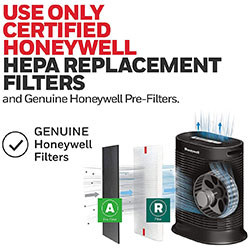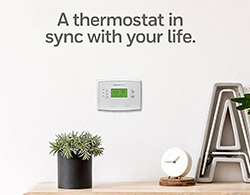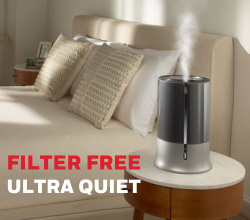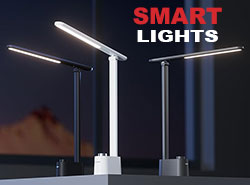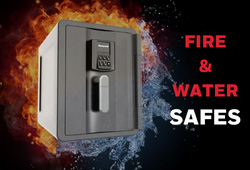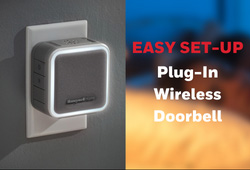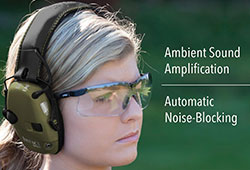Furnace Filters for HVAC Systems
Furnace HVAC Filter Guide: How To Measure Air Filters And Understanding MERV Rating
The Honeywell Store offers a robust range of Honeywell Furnace Filters for HVAC Systems. Capable of improving the quality of air you breathe by capturing dust, allergens and more potentially hazardous contaminants, Honeywell Furnace HVAC Filters are available in a variety of sizes (1 in. filters are also now available!) and MERV types. A large selection of sizes ensures a wide compatibility range when selecting the appropriate air filter for your furnace. If you're new to purchasing an HVAC filter, you'll want to get the sizing just right to ensure the best performance possible. Here's an easy step by step guide for doing just that:
Measuring Furnace Filters for HVAC Systems
-
Step 1: You'll want to turn off your HVAC unit before removing the air filter.
-
Step 2: Locate your home's HVAC system and remove the air filter.
-
Step 3: The measurements of the filter should be printed on its side. If they're not, don't worry! Simply grab a tape measure and do the following:
-
You'll want to measure the filter's length and width. This will provide you with the filter's (L x W).
-
You'll then want to measure the filter's thickness (or depth) from front to back (D). This will always be your smallest number.
-
Now gather all of the numbers together. The result should look like this (L x W x D). Congratulations! These are the measurements of your home's HVAC Filter. Home HVAC Systems often vary in size. When you combine this with the large amount of Honeywell HVAC Filters readily available for online purchase at the Honeywell Store, it's essential that you gather the correct measurements! Now that we've covered sizing, let's take a look at MERV Rating.
Understanding an Air Filter's MERV Rating
MERV or 'Minimum Efficiency Reporting Value' is used to rate the overall effectiveness of an air filter. Below you will find a table that measures the MERV strength and tells you the application of each HVAC filter's effectiveness. In general, an air filter with a higher MERV Rating is more effective and has a broader application, but most residential homes will find the best use from an air filter that's between the 5-13 MERV rating
| MERV RATING | MIN. PARTICLE SIZE | TYPICAL CONTROLLED CONTAMINANT | TYPICAL APPLICATIONS |
| 1 - 4 | > 10.0 Micrometers | Pollen, dust mites, cockroach debris, sanding dust, spray paint dust, textile fibers, carpet fibers | Residential window AC units |
| 5 - 8 | 10.0 - 3.0 Micrometers | Mold, spores, dust mite debris, cat and dog dander, hair spray, fabric protector, dusting aids, pudding mix | Better residential, general commercial, industrial workspaces |
| 9 - 12 | 3.0 - 1.0 Micrometers | Legionella, Humidifier dust, Lead dust, Milled flour, Auto emission particulates, Nebulizer droplets | Superior residential, better commercial, hospital laboratories |
| 13 - 16 | 1.0 - 0.3 Micrometers | Bacteria, droplet nuclei (sneeze), cooking oil, most smoke and insecticide dust, most face powder, most paint pigments |
Ultra residential, best commercial, hospital & general surgery |
Honeywell Standard, High & Ultra 1 In. Air Filters
The Honeywell Store now features Honeywell One Inch Air Filters. Available in packs of four, 1 inch filters last up to three months, ensuring each purchase lasts up to one year. All 1 inch furnace filters implement easy flow energy efficiency and are encased in a heavy duty frame, ensuring lasting durability. The availability of different sizes and MERV Ratings will allow you to choose the best one inch air filter for your specific needs. Let's take a closer look at the Honeywell Store's selection of 1 in. furnace filters and how they differ from one another.
-
Honeywell Standard Efficiency 1 Inch Filters feature a MERV 8 Rating that makes them an excellent candidate to be used in residential, general commercial and industrial workplaces. Honeywell MERV 8 filters excel against dust/lint, airborne dust mite debris, pollen and pet dander.
-
Honeywell High Efficiency 1 Inch Filters see a boost in performance as they're electrostatically charged to effectively catch and trap dust particles. High Efficiency 1 inch filters feature a MERV 11 Rating that allows for superior residential and improved commercial use. Honeywell MERV 11 Air Filters excel against the aforementioned airborne irritants as well as mold spores, bacteria, microscopic allergens, virus carriers and most smoke.
-
Honeywell Ultra Efficiency 1 Inch Filters have the most powerful MERV Rating available at the Honeywell Store. Ultra Efficiency 1 inch filters feature a MERV 13 Rating that makes them a premier choice for residential and commercial applications. Honeywell MERV 13 Air Filters excel against the aforementioned airborne irritants as well as odor and smog particles.
How Often Do I Need to Replace My HVAC Furnace Filters?
It's generally recommended that HVAC Filters be replaced once every three months. There are exceptions of course. The type of furnace you implement in your home and how often you use it can play a large role in determining when to change filters. There are a few telltale signs that can also reveal when it's time for a replacement HVAC filter. If you're finding a lot of dust in the air and or settling onto furniture after cleaning a room, an expired HVAC filter can be the culprit. Your furnace running longer than usual is another sign that it might be time to replace the HVAC filter. When in doubt, it's best to simply take a look at the current condition of the filter. If it's doused in dust or showing signs of visible damage then it's definitely time for a replacement.
Learn more about when to change your furnace filters